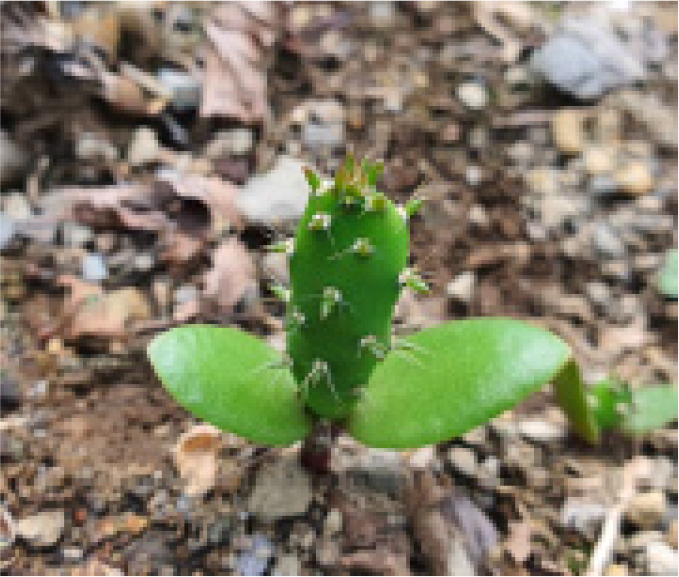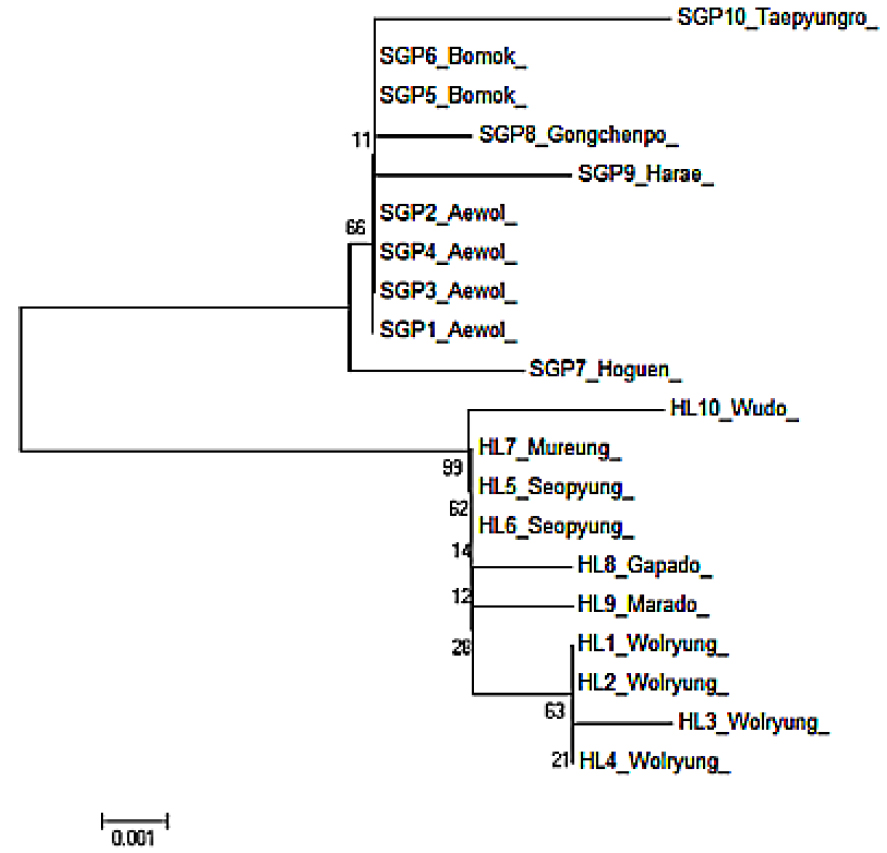서 언
재료 및 방법
표본 채집 및 보관
유전자 증폭 및 정제
결과 및 고찰
외부 형태 형질 비교
한국의 Opuntia속 선인장의 검색표
Key to Opuntia ss. in Korea
계통유연관계 분석
분류군기재
적 요
서 언
다육식물이면서 현화식물인 선인장과(Cactaceae)는 남북아메리카 대륙에 주로 자생하며, 현재 전 세계에 서식하고 있다(Majure et al., 2012b). 선인장과(Cactaceae)는 부채선인장아과(Opuntioidae), 나뭇잎선인장아과(Pereskioideae), 의사엽선인장아과(Maihuenioideae), 기둥선인장아과(Cactoideae)의 4개의 아과(subfamilies)로 구분한다(Nyffeler and Eggli, 2010). 이중 부채선인장아과(Opuntioidae)에 포함되어 있는 부채선인장속(Opuntia)은 약 200여종이 포함될 정도로 큰 속(Genus)에 해당되는데(Anderson, 2001), 손바닥선인장으로도 불린다. 한국에는 제주 서부지역 애월에서 제주 남동부지역인 남원지역 해안가에 걸쳐 자생하고 있는 Opuntia monacantha Haw.와 제주 서부 한림지역에서 제주 동부 우도 해안까지 자생하는 해안선인장(Opuntia stricta Haw.)이 있고(Yang et al., 2020), 충청도, 경상북도, 전라도 지역에서 재배되는 천년초(Opuntia humifusa Raf.)와 왕가시천년초(Opuntia humifusa Raf. f. jeollaensis E. J. Kim & S. S. Whang)가 있다(Kim et al., 2014; Park et al., 2013). 한국의 부채선인장들은 혈액순환, 노화방지, 암 발생 및 콜레스테롤 수치를 낮추는 역할을 하며(Frenandez et al., 1992), 항산화, 해독, 진통 작용(Ahn, 1998; Chung, 2000; Kim, 1996; Xinwenfeng Publishing Co., 1982)과 면역세포의 활성화(Shin and Kim, 1998) 등에 효과가 있는 것으로 알려져 있다.
한편 분류학적 연구로는 O. stricta의 nrITS 유전자 분석만 있어(In et al., 2006), O. monacantha에 대한 유전자 분석과 두 분류군의 계통 비교, 나아가 그 기원을 밝히는 분자진화적 계통 연구가 더 필요하다.
O. monacantha에 대한 Koh et al. (2018)의 연구가 실제 제주에 분포하고 있는 O. monacantha와 형태학적인 형질 차이가 보인다는 의견이 제기되어왔다.
이에 본 연구는 제주도에 자생하는 부채선인장속 식물군을 대상으로 외부형태 형질과 핵 유전자 nrITS와 와 색소체 유전자인 matK 와 atpB-rbcL을 기준으로 계통분류학적 분석을 수행하여 Opuntia속 간의 계통 유연관계를 명확하게 규명짓고, O. monacantha의 명확한 지위를 주어 국명을 명명하고자 한다.
재료 및 방법
표본 채집 및 보관
제주도에 서식하는 부채선인장속인 O. monacantha와 O. stricta 2종을 대상으로 2017년 6월부터 12월까지 각각의 자생지에서 어린 1년생 개체를 채집하였다(Table 1). 채집한 재료는 외부 형태적 연구와 줄기에서 DNA 염기서열을 분석하는 데 이용하였다(Table 1). DNA 염기서열 분석에 사용한 재료 중 O. stricta는 한림읍 월령리 표본을 O. monacantha는 서귀포 호근동 표본을 대표로 국립산림과학원 난대・아열대산림연구소 표본관에 건조표본으로 보관하였다. 나머지 표본은 생체로 서귀포 호근동 소재 백년초박물관에 보호 재배중이다(O. monacantha voucher number: WTFRC-10033485-69940, O. stricta voucher number: WTFRC-10033489-70100).
Table 1.
Collection localities of specimens for gene analysis
확보된 재료(엽상경)는 깨끗이 증류수에 세척하여 액체 질소에 동결시켜 –80℃에 보관한 후 DNA를 추출하였고, 핵 유전자인 nrITS와 엽록체 유전자인 matK와 atpB-rbcL의 염기서열을 결정하고(Table 2), 제주지역 부채선인장속 두 분류군의 변이 양상을 비교하여 계통유연관계를 분석하였다. 제주도 자생 선인장 2종의 Opuntia s.s.내의 유연관계를 확인하기 위해 외군(outgroup)으로 Tacinga series를 이용하였고, 외국 종과 외군의 염기서열에 대한정보는 미국 NCBI (GeneBank)를 통해 얻었다.
Table 2.
DNA regions and associated primers
| Region | Primer name: sequence or referen |
| nrITS |
ITS4: (White et al., 1990) ITS5: (White et al., 1990) |
| matK | matKx: (http://www.kew.org/barcoding/update.html) matK5: (http://www.kew.org/barcoding/update.html) |
| atpB-rbcL | atpB Op : 5′-GTAAACTATGTCGAAATTCTTTGC-3′ rbcL Op : 5′-ACAACAAAACAACAAGGTCTACTC-3′ |
유전자 증폭 및 정제
PCR은 initial denaturation 단계는 94℃, 5분, 1 cycle, cycling 단계는 denaturation 94℃, 30초, annealing 55℃, 30초, extension 72℃, 2분의 순서로 35 cycles, final extension 단계는 72℃, 10분, 1 cycle 조건으로 수행하였으며, 이후 Montage PCR Clean up kit (Millipore)를 이용하여 DNA를 정제하였다.
nrITS, matK와 atpB-rbcL 유전자의 염기서열 분석
O. monacantha와 O. stricta의 각 3가지 유전자에 대한 염기서열 결정은 Big Dye 터미네이터 주기 염기서열 분석 키트 v.3.1와 자동화 DNA 시퀀싱 시스템(Applied BioSystems, 모델명: 3730XL, USA)을 이용하여 수행하였고, 이 과정은 ㈜마크로젠에 의뢰 하였다.
염기서열 결정을 통하여 연구 대상종의 DNA 염기서열이 완전하게 확인된 후에는 분자 진화학적인 관점에서 근연종들과의 서열을 비교 분석하였다(Majure etal., 2012a, b). ClustalX 프로그램을 이용하여 염기서열을 정열하고(Thompson et al., 1977), Bioedit 프로그램(ver 7.2.6.2)을 사용하여 Opuntia속과 Tacinga series (outgroups)의 염기서열을 편집 및 재정렬하였다. 종간 계통 유연관계의 확인을 위해 BI와 NJ분석을 수행하였으며, MrBayes–3.2.5 프로그램과 MEGA X를 각각 이용하였다. BI 분석을 위한 진화적 모델은 GTR+I+G, NJ 분석의 경우 Kimura 2-parameter를 사용하였다. 이때 나온 결과인 con.tre파일로 각 종간 계통 유연관계를 밝힐 수 있는 분자계통도를 작성하였고, 분자계통도의 확인은 FigTree v1.4.3 프로그램을 이용하였다.
결과 및 고찰
외부 형태 형질 비교
제주 부채선인장속 두 분류군 간의 생육상태, 줄기(엽상경), 꽃, 열매, 가시의 형질을 이용하여 분류하였으며, 외부형태학적 특징은 다음과 같다.
채집 지역의 모든 군락에서 O. monacantha는 2 m 이상 자랐고, O. stricta는 1 m를 채 넘지 않았다(Anderson, 2001). 이 결과로 O. monacantha Haw.는 본줄기가 곧게 자라고 가지가 뻗쳐나간 형태의 교목성 다육식물이고, O. stricta 는 줄기가 사방으로 퍼져나간 형태인 관목성 다육식물이라는 것을 알 수 있었다.
O. monacantha의 줄기(엽상경, cladode) 모양은 줄기 시작과 끝의 폭이 좁은 장타원형(Oblong)에 가까운 형태이며(Fig. 1A), O. stricta는 도란형(Ovate or Obovate)이다(Fig. 1B). O. monacantha의 본줄기에서 1년 자란 엽상경의 크기는 장경(길이) 26 ㎝, 단경(폭) 12 ㎝였으며, O. stricta는 장경(길이) 15 ㎝, 단경(폭) 8 ㎝이다. O. monacantha가 O. stricta보다 줄기(엽상경)의 크기가 장축과 단축 모두 컷다.
기존 연구(Kim et al., 2016; Koh et al., 2018)에서 제주도의 부채선인장은 주로 5월에서 7월 사이에 개화한다고 하였다. 그러나 O. monacantha는 5월 초순부터 다음 해 1월까지 개화하는 것이 관찰되었고, O. stricta는 6월 중순부터 8월 초까지 개화하여, 두 개체군의 개화 시기와 기간이 다르다는 것을 알 수 있었다.
꽃망울 색은 O. monacantha는 붉은색, O. stricta는 녹색을 띠고 있다. O. monacantha는 엽상경의 가장자리에 꽃이 피고, 꽃의 크기가 5 ㎝라는 종전의 연구(Koh et al., 2018)와 달리 엽상경의 가장자리뿐 아니라 엽상경 몸통부위에도 꽃이 피고(Fig. 1G), 꽃의 직경이 O. monacantha는 약 6~7 ㎝, O. stricta는 직경이 5~6 ㎝로 O. monacantha의 꽃이 다소 크다는 것을 확인하였다(Table 4).
꽃잎(tepal)은 약 20여 개이며, O. monacantha의 바깥쪽 꽃잎은 작고, 안쪽으로 갈수록 크기가 커져 일반 식물의 꽃잎과 그 배열이 상반되는 경향이 있으며, 뒷면에 자주색 줄무늬가 있었다(Koh et al., 2018; Fig. 1E). 한편, O. stricta는 뒷면에 자주색 줄무늬가 없고 노란색을 띠었다(Fig. 1F).
O. monacantha의 열매는 꽃이 진 후 2~3개월에 걸쳐 녹색에서 차츰 붉은색으로 변하는 것을 관찰할 수 있었다. 열매의 모양은 O. monacantha는 몸통이 둥근 자두 모양에 가깝고, O. stricta는 몸통이 긴 서양배 모양을 띠고 있었다(Fig. 1C and D). 성숙한 열매의 크기도 O. monacantha는 장경 7~8 ㎝, 단경 5 ㎝에 가까웠고, O. stricta는 장경 5~6 ㎝, 단경 3 ㎝ 정도로 작았다(Fig. 1C and D).
또한 다른 식물에서는 줄기에서 열매가 자라는 것이 일반적이지만, 제주도에 서식하는 O. monacantha는 열매에 꽃망울이 맺히는 특이점이 발견되었고, O. monacantha는 열매에서 줄기가 자라는 것이 관찰되었다(Fig. 2). 이런 특이한 형질이 개체별로 일관성 있게 확인되어, O. monacantha Haw. 본종이 제주도 유입 후 유전적으로 고정된 종 동정을 위한 형질로 될 만큼 고착화된 것으로 판단된다. 또한 열매에서 줄기가 자라는 현상을 통해서, 열매의 자좌(areole)가 줄기의 자좌와 같은 기능을 한다는 것을 알 수 있었다. 이에 따라 본종인 O. monacantha Haw.와 다른 획득형질이 관찰됨에 따라 추후 추가적인 형질 차이 연구를 통해서 변종 또는 신품종으로 분류해야 할 것으로 본다. O. monacantha는 O. stricta보다 엽상경의 자좌 간격이 2 ㎝ 이상 크며(Fig. 1A and B), 강모가 0.5~1 ㎝ 정도 크다는 것을 알 수 있었다(Fig. 1I and J), Koh et al. (2018)은 꽃잎이 30여 개이고, 암술머리의 두부는 5갈래, 수술은 수백 개, 열매는 서양배 모양, 종자는 퇴화되었거나 없으며, 엽상경은 난형 또는 도란형(Ovate or Obovate)이라고 하였다. 하지만, 본 연구에서는 꽃잎이 20여 개, 암술은 1개이고, 암술머리는 5~6갈래로 갈라지며, 수술이 180~200여 개이고, 열매는 자두모양, 종자는 큰 것이 1개~2개 (6 ㎜), 작은 것이 50여 개(2~3 ㎜)인 것을 관찰 하였으며, 발아하여 싹을 틔웠다(Fig. 3). 또한 엽상경은 장타원형(Oblong)을 띤다는 것이 확인되었다. O. monacantha에 대한 생태학적 접근을 통한 기존 연구(Koh et al., 2018)에서 본 분류군을 왕선인장으로 소개하였으나, 증거표본제시, 형태학적 형질에 대한 검색표, 분류군을 비교하기 위한 대조군, 분자 유전적 실험, 분류학적 연구 결과가 전무하고, 형태적 특징은 상당 부분 오기되어 있다. 따라서 본 연구에서는 제주도에 분포하고 있는 O. monacantha는 왕선인장이 아니다는 결론을 내리게 되었다(Table 3). 기존 연구(Koh et al., 2018)에서 왕선인장을 O. monacantha와 O. stricta를 혼돈하여 명명한 것인지 어떤 분류군으로 명명한 것인지 대해서는 알 수가 없다.
Table 3.
Comparison of the Characteristics of O. monacantha and Wangsuninjang
한국의 Opuntia속 선인장의 검색표
한국의 다른 부채선인장과의 형태적 특징(Table 4)을 비교한 검색표를 동절기 엽상경의 쭈글거림, 꽃의 색, 줄무늬, 가시등의 형태학적 특징을 기준으로 아래와 같이 정리하였다.
Table 4.
Morphological characteristics of Opuntia s.s. in Korea
Key to Opuntia ss. in Korea
1. 겨울에 엽상경이 쭈글거리고, 바닥에 몸통 줄기가 누움
2. 노란색 꽃잎을 가지고, 짧은 구침과 엽침을 가짐………………………O.humifusa 천년초
2. 노란색 바탕에 중심부가 붉은색인 꽃을 가지고 있고, 길고 강한 구침과 많은 엽침을가짐…………………O. humifusa f. jeollaensis 왕가시천년초
1. 겨울에 엽상경이 쭈글거리지 않고, 몸통 줄기가 바로 서있음
3. 노란색 꽃잎을 가지고, 짧은 구침과 많은 엽침을 가짐…………………O. stricta Haw. 해안선인장
3. 노란색 꽃잎의 뒷면에 보라색 줄무늬가 있고, 길고 강한 구침을 가짐…………………O. monacantha Haw. 제주백년초
계통유연관계 분석
nrITS 유전자를 이용한 Bioedit 프로그램(Hall, 1999) 으로 얻은 fasta파일로 Mega 6 (Tamura et al., 2013) 프로그램을 활용한 NJ Tree는 bootstrap을 1000회 반복으로 도출한 결과 O. monacantha와 O. stricta가 서로 다르게 분지 되었다는 것을 알 수 있었다(Fig. 4). 또한 관련된 분류군이 함께 모일 수 있는 복제 tree의 비율(확률)이 Branch 옆에 표시 하였다(Felsenstein, 1985). tree는 Phylogenetic tree를 추론하는 데 사용 된 Evolutionary distance와 동일한 단위로 branch 길이로 축척하여 나타냈다. 두 분류군의 샘플을 각각 10개씩 하여 연구한 결과에서 두 분류군이 Phylogenetic tree에서 명확히 분지되어 나타나 서로 다른 종이라는 결론을 내릴 수 있었다.
지금까지 제주지역 부채선인장 두 분류군의 위치는 유전자 수준에서 연구된 바 없어 nrITS 유전자와 Plastid (atpB-rbcL and matK) 유전자를 통한 계통분류학적 유연관계를 밝혔다는 점은 높게 평가할 수 있겠다. 부채선인장 두 분류의 계통분류학적 위치를 찾기 위해 Majure et al. (2012b)의 연구를 토대로 Genebank (NCBI)에서 nrITS, atpB-rbcL, matK 유전자 104종을 찾아 nxs 파일로 변환하여 FigTree 프로그램을 활용한 분자계통학적 분석을 하였다.
기존 연구(Kim et al., 2014)에서와 같이 이번 연구에서도 O. humifusa, O. humifusa f. jeollaensis 두 분류군의 유연관계 결과 모두 North America Clade에 포함되어 있었으며, O. humifusa는Humifusa series에 포함되어있고, O. humifusa f. jeollaensis는 Macrocentra series에 포함된 것으로 밝혀졌다(Majure et al., 2012a). 또한 O. monacantha (seogwipo Opuntia cactus)는 South American Clade인 Elatae series에 포함되어있고, O. stricta (Hallim Opuntia cactus)는 North American Clade인 Scheerianae series (Majure et al., 2012a)에 포함되어 있다(Appendix 1.).
지금까지 제주의 부채(손바닥선인장 두 분류군의 기원에 대해서는 정확히 알 수 없어 북미멕시코에서 유입된 종(Kang et al., 1989)으로 발표하였으나, 이번 연구를 통해서 제주에 서식하고 있는 두 분류군 모두 본 분류군과 마찬가지로 O. monacantha는 남아메리카 대륙, O. stricta는 북아메리카가 원산지라는 것(Majure et al., 2012a)을 확인할 수 있었다.
Majure et al. (2012a,b)의 연구 결과와 같이 Appendix 1.에서도 Opuntia s.s.중 North American Clade에서 이질배수체 종이 서로 잡종을 형성하여 다배체 종분화가 일어나는 망상진화의 형태로 방사진화 한다는 결과가 나타났다.
그리고, O. monacantha는 대표적인 제주도의 민속식물로 백년초라(Koh et al., 2018; Kwon et al., 2017a,b,c; Yang et al., 2017) 불려져 왔으며, 지리적 입지조건과 상징적 특성을 고려하여 국명을 ‘제주백년초’로 명명한다.
분류군기재
1. Hae-an-sun-in-jang
Opuntia stricta(Haw.) Haw., Syn. Pl. Succ. 191. 1812; Benson, Cacti U. S. Canada, 931. 497. 1982; Telford in A. S. George et al., Fl. Austr. 4: 71. 1984
Cactus strictus Haw., Misc. Nat. 188. 1803
2. Jeju-baik-nyun-cho
Opuntia monacanthaHaw., Suppl. pl. succ. 81. 1819
Cactus monacanthos Willd., Enum. pl. suppl. 33. 1813
Opuntia monacantha var. variegata Coll. Cact. Alexandra Park (Darrah) 57. 1908 fide Britton & Rose, Cactaceae, 1: 157. 1919
적 요
제주도에는 줄기, 열매, 꽃, 가시, 개화시기가 서로 다른 부채선인장이 분포하고 있다. 아직 이 두 분류군에 대한 비교 연구가 없어 같은 종으로 취급하는 경우가 많다. 이에 본 연구는 제주도에 자생하고 있는 O. monacantha와 O. stricta 두 분류군의 계통학적 유연관계를 밝히기 위하여 이루어졌다. 연구 결과, nrITS와 엽록체 유전자 matK, atpB-rbcL유전자 분석을 통해서 두 개체군이 전혀 다른 종이라는 것이 밝힐 수 있었다. 또한 두 분류군 중 O. monacantha는 Elatae series에 포함되어 있어 남아메리카가 원산지이며, O. stricta는 Scheerianae series에 포함되어 북아메리카가 원산지라는 것을 확인할 수 있었다. 그리고, 제주도에 분포하고 있는 O. monacantha에 대해서 지리적 입지조건과 상징적 특성을 고려해 국명을 ‘제주백년초’로 명명하였다.
Appendix 2~4
- kjpr2021345451_S1.pdf
Appendix 2. Genbank (NCBI) accession number (nrITS)
- kjpr2021345451_S2.pdf
Appendix 3. Genbank (NCBI) accession number (rbcL)
- kjpr2021345451_S3.pdf
Appendix 4. Genbank (NCBI) accession number (matK)









